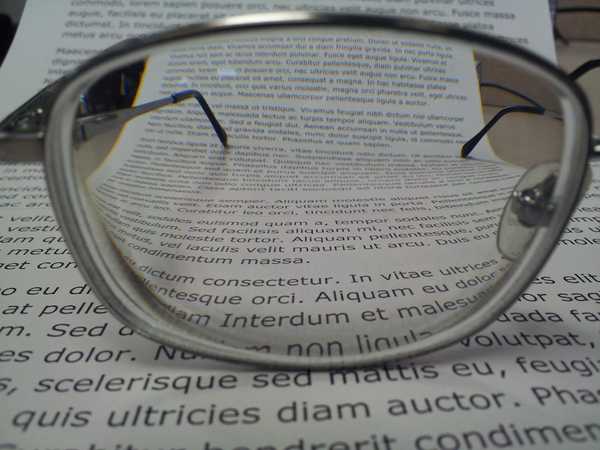Learn The Best Glasses For Reading And Computer
There are many solutions to restore up close reading vision when you get older.
Reading glasses are the most basic option to correct loss of reading vision (called presbyopia). They are the choice for those who already have perfect distance vision. Some contact lens wearers also choose to use reading glasses over their contact lenses to provide up close vision.
Reading glasses focus entirely at a single distance in front of you. This distance is determined by the prescription of the reading glasses. Reading glasses typically start at a prescription of +1.00 and increase to around +3.00. These numbers actually mathematically determine how close you need to hold something to bring it in focus with the glasses. Higher numbers means you have to bring in objects closer. Lower numbers mean objects are in best focus further out. For reading vision, +2.00 to +2.50 is the best for most people.
When getting reading glasses, it is also important to consider how often you do other tasks such as working on a computer. Computer screens typically are further out than you would hold a book (typically the length of an arm). This distance corresponds closely to a reading glasses prescription of around +1.50. Some people prefer to get separate +1.50 computer glasses that they keep at their computer workstation. Others prefer to split the difference between computer focus and reading focus and so a +2.00 pair of reading glasses works better. It’s just a matter of preference. So go ahead, try them on in the store to see what best fits your bill.
Lastly, expect to lose or misplace many reading glasses! And unless you carry the reading glasses around with you and/or dangle them around your neck on a necklace or chain, it is very helpful to buy many cheap pairs to scatter around your house. That way you can always find a pair nearby when they are needed!
Also check out What Is The Best Reading Glasses Prescription After Cataract Surgery? on EyeMountain.com
What Are Progressive Glasses?

Progressive Glasses; Image by Stanistani, CC BY-SA 3.0, via Wikimedia Commons
For those with perfect distance vision or for those who use distance contact lenses, reading glasses is their solution to correct up close vision. For everyone else, the default method tends to be progressive glasses. And progressive glasses can be a great solution to restore up close reading vision.
Progressive glasses get their name by the fact that when you slowly look from distance down to a book in front of you, everything stays in focus; The glasses progressively add power to keep everything sharp from distance vision to up close vision and everything in between. Sounds magical! So how do they work?
Reading glasses work by adding prescription to your eyes to make your vision “near-sighted” to focus on books and cell phones. Progressive lenses do the same thing but they only add prescription at the very bottom of the lens.
Prior to progressive glasses, bifocals used to be the primary way to provide distance and up close vision in glasses. Bifocals, however, come with the disadvantage of being very obvious that they are bifocals. This is where progressive glasses shine.
Like progressive glasses, bifocal glasses also have the reading prescription at the bottom of the glasses on top of your normal glasses prescription. When you read a book, your eyes look down through the extra prescription but when you are looking in the distance, you look up above the extra reading prescription. Unlike bifocal glasses, however, there is no “all or none” with progressive glasses. As you move up in progressive glasses, the reading power (progressively) gets less and less until the added power is zero and you are just looking through your distance prescription. Progressive glasses can also provide computer vision as well. You have to get into trifocals with three separate lenses in order to match the whole range that progressive glasses can provide.
Cosmetically progressive glasses also look better than bifocal glasses. You can’t actually see the added prescription. In comparison to bifocals, there is no ugly obvious line. The prescription is actually blended with the rest of the glasses. Thus, nobody even knows you need progressive glasses to read! Your secret is safe from everyone (except your optometrist or ophthalmologist 😉)
Difficulties With Progressive Glasses

Downsides of Progressive Glasses; Image by Sewn Apart on Unsplash
For all the good that progressive glasses provide, there can be some roadblocks to achieving perfect vision with the glasses. Vision during some activities which may be more difficult than others.
Progressive glasses rely on a few certain assumptions. When you read, progressive glasses assume that you don’t move your head a whole lot. Instead, by just moving your eyes and keeping your head in the same spot, the eyes travel through the whole range of the progressive glasses. And for most people, their eyes line up well enough with the reading section of the glasses to provide reading vision.
But not everyone! Some people may move their head too much. Some people may have glasses that are extra tall and so their eyes never reach the reading section. Some people compensate by tilting their chin up to try to see better. Despite having a perfect prescription in the glasses, these situations can make it impossible to read up close.
So what to do? It’s very easy to be lost in the shuffle, but nothing can replace seeing an experienced provider who excels at getting all these intangibles correct. Only then can they take the time to understand best how to fit the glasses to you.
But there's more! Progressive lenses have different zones. There is a zone for looking in the distance and a zone for reading. And right in the middle of those two there is a zone for looking at objects at arm's length such as a computer screen. However, the zones aren't equal. The computer zone is actually more narrow than the distance and the reading zone. This leaves a small sweet spot for optimal computer vision. If you look too much to the side, the computer will start to become blurry.

Getting the computer in focus; Image by Pxhere, CC0, via Wikimedia Commons
Not to mention that non-standard computer setups may make it even more difficult. It takes time to adjust to learning how to use the glasses to see things clearly and summoning up patience when things are difficult to see.
Fortunately, as with most things in life, you get used to this zone over time. It can be a little challenging in the beginning but eventually it becomes instinctual to look at the computer at the right angle and direction and with the right head position. Also fortunately, manufacturers of progressive glasses have figured out ways to expand the computer and reading zones of progressive glasses to provide an easier ability to see all distances with these glasses. So while progressive glasses look very simple, there can be quite a bit of technology involved in getting your vision right!
Related Articles
Also check out EyeMountain.com for more great eye articles
Please note: The general information provided on the Website is for informational purposes only and is not professional medical advice, diagnosis, treatment, or care, nor is it intended to be a substitute therefore. See the Disclaimer and Terms of Use for more information
.jpg)